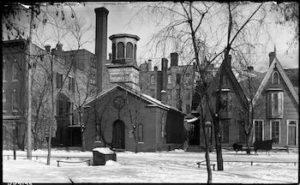
Market Street Methodist Church
*This date in 1799 is celebrated as the birth date of Jim Thompson. He was a Black laborer, translator, and trapper in the Minnesota territories.
James Thompson was born a slave in Virginia. His first trip into Minnesota territory came in 1827 with his owner, sutler John Culbertson, while he sold slave-produced merchandise to the First Infantry stationed at Fort Snelling. Thompson’s first owner, George Monroe (the nephew of President James Monroe), sold him as payment for a gambling debt. While staying at Fort Snelling, Culbertson sold Thompson to Officer William Day.
In 1833, Thompson, still living at the Fort with Day, married the daughter of the Dakota leader Mahpiya Wicasta (Cloud Man) and began to learn the Dakota language. Day took Thompson along when he was reassigned to Fort Crawford in Prairie du Chien in 1836. In 1837, the Methodist missionary Alfred Brunson searched for an interpreter to help him teach the Methodist faith to the indigenous Indians near Fort Snelling. He sought a man who shared his faith and could communicate its tenets to the Dakota. Believing Thompson to be a committed Methodist and recognizing his unique relationship with the Dakota, Brunson chose him to be his mission's interpreter. Brunson was able to buy Thompson's freedom on May 19, 1837.
Happy to be reunited with his wife, he returned to the Fort and began the area's first Methodist mission in the Dakota village of Kaposia, located ten miles down the river from Fort Snelling. The mission's land was given to them by the Dakota leader Wakinyatanka "Big Thunder" (Little Crow III), who, through either a budding Methodist faith or a pragmatic understanding of his people's relationship with the growing white-immigrant community, welcomed the new mission. All of that changed in 1839. Wakinyatanka no longer allowed his children to participate in the mission, and attendance stopped. Brunson left the church and moved it to present-day Newport soon after.
Thompson left Kaposia and began selling liquor near Fort Snelling. In May 1840, Thompson and other whiskey-selling squatters were forced to move and settle in a small community called Pig's Eye, later renamed St. Paul. During this time, Thompson worked as a carpenter. He helped construct the house of Edward Phelan and John Hays, which was considered the first home built in St. Paul. He also built and operated the first ferry boat between the current downtown and West St. Paul. By 1841, the Thompsons had settled in the area and had two children, a daughter named Sarah and a son George. Thompson was the first Black resident in the city, then a small community that relied so heavily on kinship; his family was welcomed as residents of what would eventually become the state capital.
In 1849, Thompson helped build a new Methodist church (pictured) in the city's downtown area. He donated money, land, and materials, including 1,500 shingles and two thousand feet of lumber. After statehood, at the onset of the U.S.-Dakota War in 1862, Thompson and his family lived near the Lower Sioux Agency. Thompson left his family for the safety of Fort Ridgely, Minnesota, realizing that his Dakota wife and Black Dakota children would remain safe. After the war, Thompson was reunited with his family and eventually returned to St. Paul. Years later, Thompson left Minnesota, following his son to Nebraska to live on the Santee Sioux Reservation. He died there on October 15, 1884.